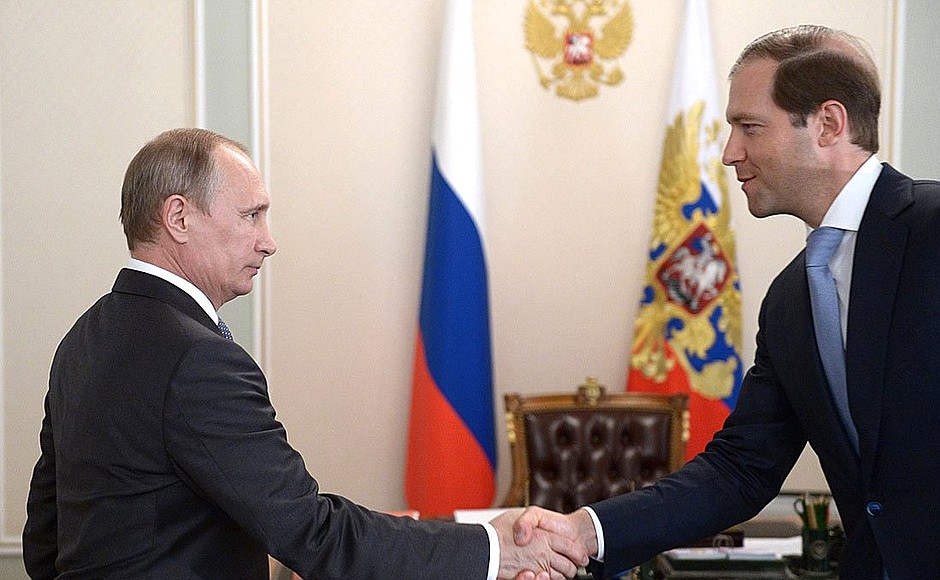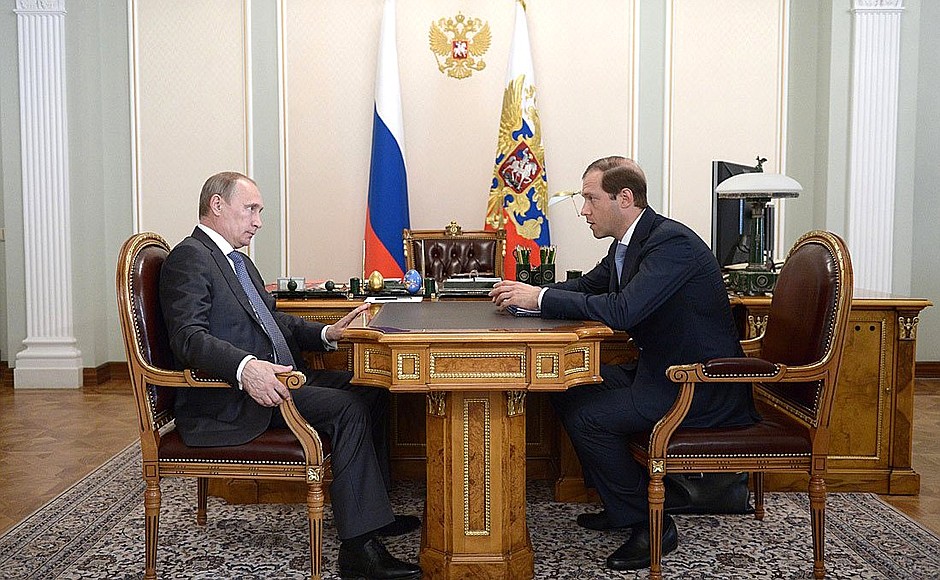President of Russia Vladimir Putin: Good afternoon, Mr Manturov.
What is your assessment of the overall situation in the sector at the moment?
Industry and Trade Minister Denis Manturov: The situation with composite materials?
Vladimir Putin: No, the situation in the sector in general, your assessment of the areas for which your ministry is responsible.
Denis Manturov: The statistics offer quite a diverse range of results for the first half of the year. The processing industries that come under our ministry’s responsibility had growth of around 3.7 percent. The aircraft manufacturing industry was the main growth sector. Light industry grew by around 7 percent. The automotive industry is facing some difficulties at the moment and car production was down by 2.5 percent over the first half. The biggest drop was in production of light commercial vehicles, trucks and buses. Light commercial vehicles suffered most of all because they are used mostly in the small and medium business sector. But limited access to credit resources means that businesses are often unable to upgrade their vehicle fleets.
As for other sectors, the metals industry is slowly starting to recover, and we are actively developing new industries at present. You gave an instruction on composite materials at the very first meeting of the Commission for Modernisation [and Technological Development of Russia’s Economy], and we have prepared a presentation on what is happening in this area.
Russia has good potential for developing this sector and good prospects for developing consumption of composite materials. The global market is growing by 5–7 percent a year on average. These materials are used primarily in the housing and utilities sectors, transport infrastructure, aviation, space, and energy sectors here in Russia.
But our per-capita consumption of composite materials is 15 times less than that of other developed countries and works out at only half-a-kilo per person.
Vladimir Putin: We produce less too.
Denis Manturov: Yes, we produce less and we consume less. This is why overall, the package of measures that we drafted as a separate sub-programme, acting on your instruction…
Vladimir Putin: Where is the work taking place?
Denis Manturov: A large number of companies are involved. There are big holdings, a subsidiary of Rostec, HC Composite, for example, and companies that have been set up with RUSNANO’s involvement, and there are a large number of small and medium businesses working in the processing industry. It is mostly big companies that are involved in production of threads, prepregs and resins, while small and medium businesses are engaged in producing the finished products.
The main task is to create a favourable environment for consumption, and this will in turn encourage increased production. To achieve this, we are currently working hard on changing the regulations and drafting new rules and regulations, standards and budget documentation.
Four sector-based programmes have been launched, overseen by the Industry and Trade Ministry, Energy Ministry, Transport Ministry, and the Regional Development Ministry. We are currently implementing 16 regional programmes, which were drafted in line with our recommendations, and 61 regions are currently preparing programmes.
Developing production of actual industrial products themselves and the technology for their production is one of our biggest priorities. We are doing this through the new R&D co-financing mechanism in this sector. The completely new principle that the Government introduced by its resolution at the end of last year involves participants in the development process taking on not only co-financing obligations but also obligations to commercialise the resulting products and spread their use in production. If they do not do this, they must return the state funds they received to the budget. We have included new provisions such as this in the draft law on industrial policy too, which has already been sent to the State Duma for consideration. We selected 25 investment projects for the end of last year and start of this year. They will receive a total of 4 billion rubles [more than $112 million] from the budget until the end of 2016.
Two new engineering centres will help in getting new products introduced and used in the production process. They form a bridge between development and practical application. One, the Institute of Aviation Materials (VIAM) is under our ministry’s jurisdiction, and an engineering centre has been set up there. The other centre is located at Rostec subsidiary, HC Composite. Two more centres are in the process of being established at the moment, one at Bauman Moscow State Technical University, and the other at Kazan National Research Technical University.
At the same time, we are expanding capacity at key companies, in particular at TVERSTEKLOPLASTIK, where production of integral composite large-size components for the construction industry has been organised. Moscow company Prepreg-SKM, which is located at the Technopolis Industrial Park, has begun production of fabrics and prepregs of a total volume of 5 million square metres a year. Prepreg technology makes it possible to produce large-sized components with minimum use of machine tools, and these materials are particularly in demand today in the aviation and space sectors.
New capacity already in operation also includes a facility manufacturing motorboats at the Sredne-Nevsky Shipyard in St Petersburg. Two plants belonging to the United Aircraft Corporation have begun operation in Ulyanovsk and Kazan. They cover a total area of 100,000 square metres and will produce components for the body and wings of the MS-21, which is currently in development, and in the future for other planes as well.
New models and products are also being developed at the same time. This year, we will start work on a ship using underwater wings made entirely from composite materials. We hope to replace the current fleet of Meteor boats in use in Russia. There are around 300 such boats in operation and they need to be replaced.
A unique new model of hopper car for transporting mineral fertilisers and bulk dry goods has been designed at Uralvagonzavod. It has an extended service life of 32 years and its load capacity has been increased by 15 percent. Rusagrotrans and Uralvagonzavod are currently approving a contract for construction of 1,500 cars by 2020, making use of the budget funds allocated through the Industry and Trade Ministry to subsidise the sale of innovative railway cars. This is an area in which work is going ahead actively.
A bridge design has also been developed that only takes one or at most two days to assemble. State Company Russian Highways (Avtodor) will order them for construction of bridges on federal and regional roads. They have a service life of 50 years without repair. This is to the budget’s advantage of course.
I must report too on the composite gas canister project that was presented to you back in 2012. Nizhny Novgorod company GazServisKompozit is already manufacturing around 10,000 of these canisters a month and they are on sale at retail outlets. This is 100-percent safe technology with no risk of explosion. A new technical standard has been developed and was approved on July 1 this year. The potential market for this kind of low-pressure canisters in Russia is estimated at around 200,000 canisters a year.
I just outlined a few of the projects in the civilian sectors. Overall, I want to say that production volume increased by 40 percent in 2013 as compared to 2012. Starting from this year, we expect that these sectors will grow by at least 25 percent a year. By 2020, we expect they will be producing a volume worth 120 billion rubles a year, which is five times higher than last year’s level.
Vladimir Putin: You mentioned small boats just now. We recently visited a plant that is producing small Russian-made aircraft for local routes. What is the situation like overall in this sector? We have noted many times the high demand for such aircraft. Is something happening in this area?
Denis Manturov: In the area of small aircraft and planes for regional lines, we have completed development of a programme to modernise the An-2 aircraft, which is a plane very much in demand.
Vladimir Putin: Yes, it is in demand, but it is already old hat, technologically speaking. Of course it needs a makeover, new engines, new avionics, that is all clear, but what I am talking about is completely new products.
Denis Manturov: Yes, Mr President. Tests began last year of several planes that can seat 10–12, or 16 people. This work is being carried out at the Central Aerohydrodynamic Institute (TsAGI). They are also drawing on the resources at the institute’s branch in Novosibirsk, which should have an experimental project ready for demonstration next year. In 2017, we will be ready to certify and start production of these planes.
Vladimir Putin: What about the plane we saw just recently?
Denis Manturov: That was the Rysachok light-class two-engine airplane. The tests are already underway and the company TsSKB-Progress hopes to complete the certification process for the plane by the end of this year. Next year, they hope to start series production.
We expect that local airlines based in the regions will make active use of these small planes that can land at minimally equipped airfields.
Vladimir Putin: There are still issues to sort out with the engine. They need to have Russian-made engines.
Denis Manturov: Yes, at the moment they are using Czech engines. But we have already begun developing our own engine and we hope that by the end of 2016, we will be ready to certify and produce these engines here.
Vladimir Putin: Good. Overall, compared to last year, is industry doing better?
Denis Manturov: The statistics for the first half of 2014 show that the first four months did not give much cause for optimism, but the results from the end of May and start of June show that a recovery is underway in the sectors I mentioned. This does not guarantee stable growth until the end of the year, but we are hoping for a stable figure of three percent and will do our best.
Vladimir Putin: Three percent for industrial growth?
Denis Manturov: Three percent for the processing sectors. But the figure for industry overall, I think, will be around two percent – 1.8–2 percent.
<…>


